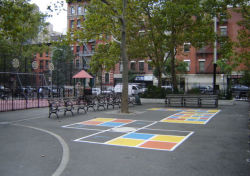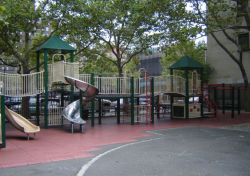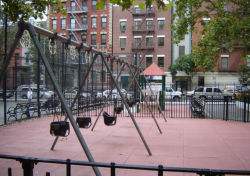Augustus St. Gaudens Playground
Augustus Saint-Gaudens Playground
Augustus Saint-Gaudens (1848-1907) was the preeminent sculptor of the Gilded Age of American art. He not only created some of the country’s finest landmarks but also helped to foster arts education and the collaboration between artists that flourished at the turn of the century. Soon after his birth in Dublin, Ireland on March 1, 1848, his family immigrated to Boston, eventually settling in New York. Saint-Gaudens was apprenticed to a cameo cutter at age 13, and began his artistic studies at Cooper Union with evening drawing classes. By 1866, he was studying full time at the National Academy of Design, where his teachers included the sculptor J.Q.A. Ward. He then completed his education at the École des Beaux Arts, where he became one of the first Americans to study sculpture formally in Paris.
After establishing a career in Paris and in Rome with commissions from traveling Americans for busts and sculptures, Saint-Gaudens returned to New York in 1875. He drew on his associations with other artists to form the Society of American Artists (1876) and the National Sculpture Society (1893) which helped to professionalize the field of art. Saint-Gaudens served as an advisor to the highly influential World’s Columbian Exposition of 1893 in Chicago. In 1904, he was appointed to the District of Columbia Board of Public Building, along with architects Daniel Burnham and Charles McKim and landscape architect Frederick Law Olmsted. Saint-Gaudens also taught at the Art Students League (founded in 1875) from the year 1888 to 1897 and helped to gain funding for the American Academy in Rome (founded in 1897).
Saint-Gaudens received some of the most prominent commissions of his time. The Admiral Farragut Monument (1880), located in Madison Square Park, was his first major public sculpture as well as his first joint project with Stanford White, who designed the pedestal. A monument to another Civil War hero, General William Tecumseh Sherman, located in Grand Army Plaza (1892-1903), is considered to be among the most distinguished equestrian groups of Western art. Other public works by Saint-Gaudens include the Peter Cooper Monument (1894) in Cooper Square, and The Shaw Memorial (1897), in Boston Common. Saint-Gaudens was commissioned by President Theodore Roosevelt to design ten and twenty dollar gold coins.
This site was acquired by Parks in 1954 and opened as a jointly operated playground in January 1966 to serve children from adjacent P.S. 40. A $720,000 renovation was funded in 1996 by Councilman Antonio Pagan. The design pays tribute to Saint-Gaudens through bronze and porcelain decorations that harmonize with the new gates, spray shower, garden area, and play equipment.
Check out your park's Vital Signs
Clean & Safe
Green & Resilient
Empowered & Engaged Users
Share your feedback or learn more about how this park is part of a
Vital Park System



